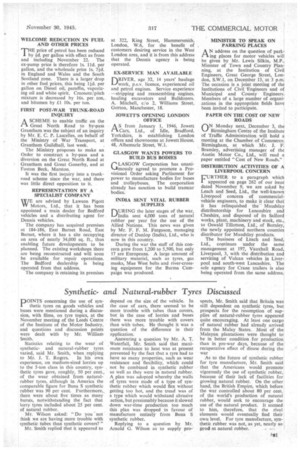Syntheticand Natural-rubber Tyres Discussed DOINTS concerning the use of syn
Page 27

If you've noticed an error in this article please click here to report it so we can fix it.
thetic tyres on goods vehicles and buses were mentioned during a discussion, with films, on tyre topics, at the November meeting of the Leeds Centre of the Institute of the Motor Industry, and questions and discussion points were dealt with by Mr. William Smith.
Statistics relating to the wear of syntheticand natural-rubber tyres varied, said Mr. Smith, when replying to Mr. J. T. Rogers. In his own experience, on medium-sized lorries up to the 5-ton class in this country, synthetic tyres gave, roughly, 50 per cent.. of the wear obtained from naturalrubber tyres, although in America the comparable figure for Buna S synthetic rubber was 90 per cent. Furthermore,. there were about five times as many bursts, notwithstanding the fact that lorry tyres included about 25 per cent. of natural rubber.
Mr. Wilson asked: "Do you not think we are having more trouble with synthetic tubes than synthetic covers?"
Mr. Smith replied that it appeared to depend on the size of the vehicle. In the case of cars, there seemed to be more trouble with tubes than covers, but in the case of lorries and buses there was more trouble with covers than with tubes. He thought it was a question of the difference in their application.
Answering a question by Mr. A. T. . Waterfall, Mr. Smith said that maximum resistance to heat was at present prevented by the fact that a tyre had to have so many properties, such as wear resistance and flexibility, which could not be combined in synthetic rubber so well as they were in natural rubber. A plan was adopted whereby the walls of tyres were made of a type of synthetic rubber which would flex without getting too hot, and the tread was of a type which would withstand abrasive action, but presumably because it slowed down war-time production too much this plan was dropped in favour of manufacture entirely from Buna S synthetic rubber.
Replying to a question by Mr. Arnold G. Wilson as to supply pro
spects, Mr. Smith said that Britain was still dependent on synthetic tyres, but prospects for the resumption of supplies of natural-rubber tyres appeared quite encouraging. At least one cargo of natural rubber had already arrived from the Malay States. Most of the Malayan plantations were thought to be in better condition for production than in pre-war days, because of the recuperative effect of disuse during the war As to the future of synthetic rubber for tyre manufacture, Mr. Smith said that the Americans would promote vigorously the use of synthetic rubber, because of their lack of facilities for growing natural rubber. On the other hand, the British Empire, which before the war controlled about 80 per cent. of the world's production of natural rubber, would seek to encourage the use of the natural product. It seemed to him, therefore, that the rival elements would eventually find their own level. For tyre manufacture, synthetic rubber was not, as yet, nearly so
gond AS natural rubber. „..




























































